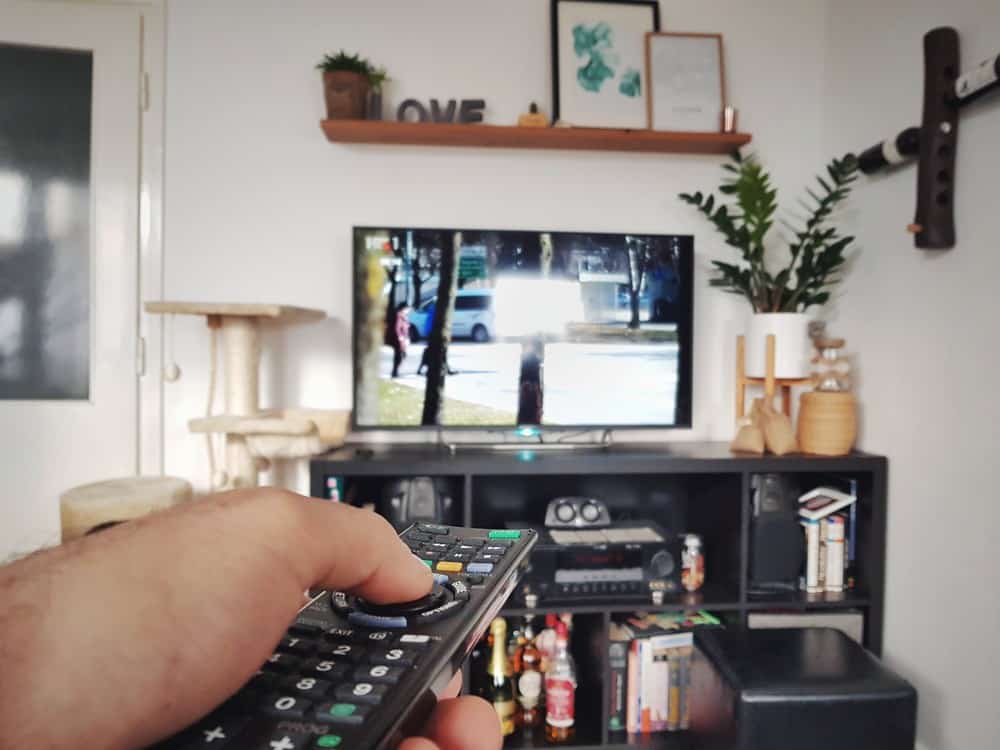The best TVs come in all display types, but the right one always depends on your needs. When comparing rear-projection TVs vs LCD TVs, it’s a generational battle. While the rear-projection television (RPTV) is a technology no longer being manufactured, you can still find them as second-hand options. And as rear projection technology is of the past, it can also be beneficial to look to the future and check out the differences between QLED TVs vs LED.
KEY TAKEAWAYS:
- Rear projections systems are no longer in production but still available for purchase used.
- LCD televisions use CRT backlighting to display an image. They are much thinner and lighter than RPTVs.
- The benefits of RPTVs are that they are inexpensive, come in many sizes, and don’t suffer from burn-in problems.
Differences Between Rear Projection and LCD TVs
The final production lines for RPTVs shuttered in 2012, but they still inhabit many homes today. At one point, RPTVs were the pinnacle of television technologies. As stated in their name, they used a cathode-ray-tube-powered rear projector inside the TV to pass a beam of light through a color wheel. The light is then reflected off a mirror and onto the screen.
Insider Tip
There are different forms of projection technology. CRT, DLP (digital light processing), and LCD are the most popular types. It’s essential to know the advantages of each when considering buying.
RPTVs were typically cheaper than the newer liquid crystal display and emerging plasma television sets. Still, the technology eventually died off because of low sales and their larger size and bulky structure.
Meanwhile, LCD technology is still sold and innovated. It’s lightweight and has impressive picture quality. LCD technology uses a flat-screen panel to filter light through multiple screens and films to enhance color.
Brightness, Light Output, and Black Levels
Back when rear projection systems were made, they had the appeal of being the closest thing to a home theatre because of their large screen size. But when it came to brightness and the overall black level, it was clear that Plasma and LED LCD TVs had more tangible benefits regarding picture quality. RPTV image quality isn’t horrid, but it doesn’t come close to the top compared to more modern achievements in a deep black level and a wide range of colors.
Viewing Angle
Something that RPTVs suffer from is poor viewing angles. Because RPTVs use what’s known as a lenticular lens for greater light output, this considerably narrows viewing angles. However, the LCD also has notoriously limited viewing angles, and a plasma television is the best option in this area.
Comparing Pricetags
Because there are no longer any new models, RPTVs are affordable compared to any other display technology and cost only a few hundred dollars. LCD TVs also come in many affordable options but generally will be more expensive than RPTVs.
However, when it comes to price, LED TVs are the most economical for the level of quality you get. When calculating your budget, it’ll be helpful to know the difference between regular TVs vs Smart TVs.
Warning
RPTVs require a bulb change, typically every few years. These bulbs are not cheap and can cost hundreds of dollars.
F.A.Q.S
Are rear-projection TVs still made?
Mitsubishi manufactured the last RPTV line before shutting it down in 2012. However, you can find them for sale used.
What do rear projection TVs look like?
Rear projector TVs are large and come with a large area under the screen that houses the projector. Unfortunately, this makes them much heavier than LED LCD options.
Where can I recycle my rear projection TV?
It’s important to remember not to dispose of a Rear Projection TV in a dump. There are hazardous materials in it and need to be handled via recycling. If you are unsure where to recycle your TV, you can contact the EPA, and they can provide you with the nearest option.
STAT: These tube-style TVs are hard to find on most appliance store shelves, though a 2014 report showed that over 46% of American households still had a CRT-style TV. (source)
REFERENCES:

































![Best Drones Under the Cost of Ferrari in [year] 25 Best Drones Under the Cost of Ferrari in 2025](https://www.gadgetreview.dev/wp-content/uploads/image-test-3.jpg)
![Best LEDs & LCDs in [year] ([month] Reviews) 26 Best LEDs & LCDs in 2025 (December Reviews)](https://www.gadgetreview.dev/wp-content/uploads/Samsung-UN65RU7100FXZA.jpg)
![Best Streaming Services in [year] ([month] Reviews) 27 Best Streaming Services in 2025 (December Reviews)](https://www.gadgetreview.dev/wp-content/uploads/netflix-750x422-1.png)
![Best Streaming Movie and Shows in [year] ([month] Reviews) 28 Best Streaming Movie and Shows in 2025 (December Reviews)](https://www.gadgetreview.dev/wp-content/uploads/Streaming-reviews.jpg)
![Best TVs in [year] ([month] Reviews) 29 Best TVs in 2025 (December Reviews)](https://www.gadgetreview.dev/wp-content/uploads/Sony-XBR55X810C-TV-1.jpg)
![Best Shows on Amazon in [year] ([month] Reviews) 30 Best Shows on Amazon in 2025 (December Reviews)](https://www.gadgetreview.dev/wp-content/uploads/The-Boys-750x474-1.jpg)
![Best Small TVs in [year] 31 Best Small TVs in 2025](https://www.gadgetreview.dev/wp-content/uploads/best-small-tv-image.jpg)
![Best 60 Inch TVs in [year] 32 Best 60 Inch TVs in 2025](https://www.gadgetreview.dev/wp-content/uploads/best-60-inch-tv-image.jpg)
![Best 50 Inch TVs in [year] 33 Best 50 Inch TVs in 2025](https://www.gadgetreview.dev/wp-content/uploads/best-50-inch-tv-imgr.jpg)
![Most Energy Efficient TVs in [year] 34 Most Energy Efficient TVs in 2025](https://www.gadgetreview.dev/wp-content/uploads/most-energy-efficient-tv-image.jpg)
![Best TVs for Apple TV in [year] 35 Best TVs for Apple TV in 2025](https://www.gadgetreview.dev/wp-content/uploads/best-tv-for-apple-tv-image.jpg)
![Best TV Antennas in [year] ([month] Reviews) 36 Best TV Antennas in 2025 (December Reviews)](https://www.gadgetreview.dev/wp-content/uploads/best-tv-antennas-image.jpg)
![Best Mitsubishi TVs in [year] 37 Best Mitsubishi TVs in 2025](https://www.gadgetreview.dev/wp-content/uploads/best-mitsubishi-tv-image.jpg)
![Best Smart TVs in [year] ([month] Reviews) 38 Best Smart TVs in 2025 (December Reviews)](https://www.gadgetreview.dev/wp-content/uploads/best-smart-tvs-image.jpg)
![Best Conference Room TVs in [year] 39 Best Conference Room TVs in 2025](https://www.gadgetreview.dev/wp-content/uploads/best-conference-room-tv-image.jpg)
![Best Dumb TVs in [year] 40 Best Dumb TVs in 2025](https://www.gadgetreview.dev/wp-content/uploads/best-dumb-tv-image.jpg)
![Best 80 inch TVs in [year] 41 Best 80 inch TVs in 2025](https://www.gadgetreview.dev/wp-content/uploads/best-80-inch-tv-image.jpg)
![Best Shows on Hulu in [year] ([month] Reviews) 42 Best Shows on Hulu in 2025 (December Reviews)](https://www.gadgetreview.dev/wp-content/uploads/The-Handmaids-Tale-750x422-1.jpg)

















